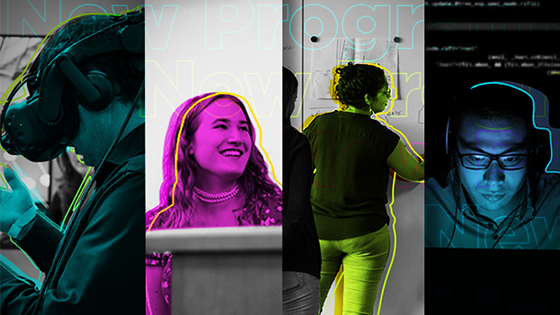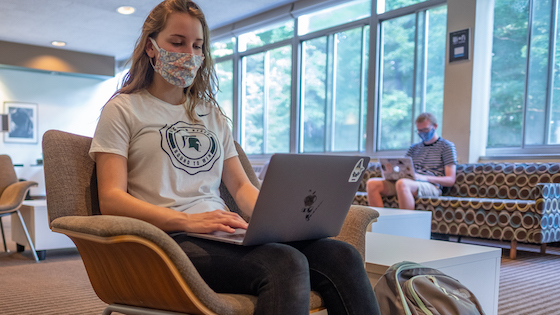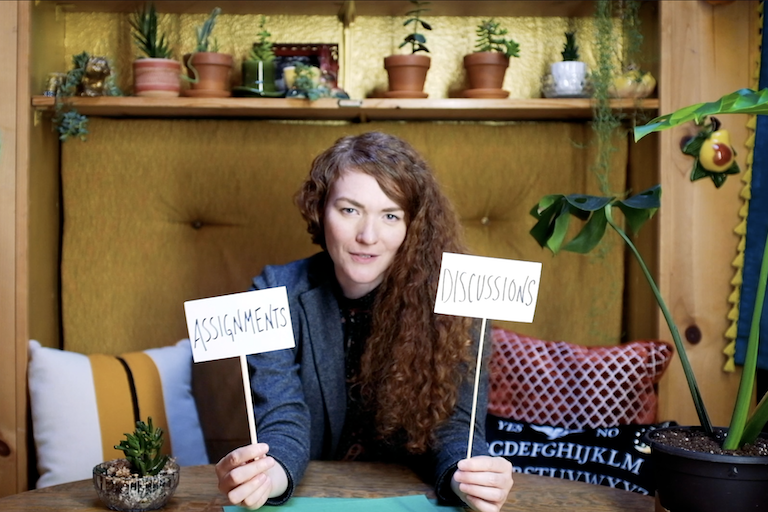Faculty Bring Animations, Video Shorts and Interactive Student Experiences to Virtual Learning
After social distancing became necessary in the novel coronavirus pandemic, professors at MSU’s College of Communication Arts and Sciences changed the way they teach courses, keeping their students at the heart of their work.
“The last time we had a pandemic like this was about 100 years ago,” said Joe Grimm, who teaches in the MSU School of Journalism. “It’s very hard personally and professionally for students to have their life disrupted this way.”
This time around, professors have technology at their fingertips, but remote learning requires professors to connect with their students differently. Many professors noticed an increase in student questions, higher levels of uncertainty, and more time invested on both sides of the screen. On top of an influx of emails, professors have seen students struggle with the same challenges other people face, ranging from economic hardship to the challenges of self-isolation.
Engaging Students in Creative Ways
Especially during these times, teaching with empathy and understanding can make a big difference in students’ lives. Professors have devoted time to listening to students about their experiences and offering their support. Jeana-Dee Allen, who is teaching Creative Thinking online to hundreds of students, said flexibility is also key, both for faculty and students.
“During the pandemic, it’s really easy to feel disconnected because we are staying at home so much,” said Allen. “One of the best things about Michigan State University is the community that we can feel. So, how do we recreate that in the virtual environment?”
To keep students engaged, she is producing short videos, visual animations and creative assignments. She has also virtually welcomed students into her home and her creative spaces, reminding students that they have someone on their side.
Faculty and staff have supported students by offering virtual office hours, virtual academic advising appointments, opportunities for extra credit, and more online resources — even virtual field experiences. Students can access these resources anywhere they have an internet connection.
"ComArtSci is committed to engaging and supporting students during these challenging times. When MSU transitioned to virtual instruction in March, our faculty and staff responded to this urgent need. Again this fall, they have risen to the challenge in creative and supportive ways," said Dean Prabu David. "I am impressed by their dedication, hard work, and student-centered approach."

Measurable Benefits of Virtual Learning
Certain aspects of the traditional classroom have not translated to online courses. In the physical classroom, some of the first things Grimm would notice included the students who sit in the front row, students who raise their hands constantly, and those who talk most during class.
“Online, you start to get a more level playing field,” said Grimm. “We see students who are maybe a little introverted and have good keyboarding skills speaking up more, because they use the chat function and respond well in a virtual format. Then, there are some people who kind of hang back.”
To mix things up, Grimm brings new ideas to his virtual courses each week. He asks his students to leave their cameras on, so he knows when a student is falling asleep or watching something on another screen. He also tries to offer moments of levity to his students. He’s hosted Crazy Hat Day, Bring Your Pet to Class Day and other themes his students can look forward to. He has turned lectures into short, segmented video blocks that students say they like, requesting the links.
Grimm has noticed that students have an easier time talking about difficult topics when they are separated by a screen. In one journalism course, he teaches ethics and how to report on trauma without causing further damage. These conversations have drawn more comments from students, who may have felt too much pressure to discuss the same issues in front of a large room.
“When taught online, that class got me more of reaction behind the scenes,” said Grimm. “With the chat function, I find that some people really find the courage to open up.”
The virtual courses have measurable educational advantages, too.
“While some students prefer the obvious advantages of an in-class experience, other students appreciate the flexibility and benefits of online classes,” said Professor Lucinda Davenport, Ph.D., former director of the MSU School of Journalism. “They like being able to repeat a lecture or to focus as long as needed on newly presented material. They can attend to class material at a time convenient to their schedules and in a comfortable environment. In addition, some students comment that online is sometimes more focused than when classroom discussions accidentally meander.”

A Tradition in High-Quality Education
In some areas of study, MSU courses have been taught in a virtual format long before it became necessary to do so.
“As Director of the School of Journalism and with the talents of enthusiastic Journalism faculty, I put our Journalism curriculum online about 10 years ago. It was one of the first in the country and also at MSU to enable students to have jobs and internships around the world while also progress in their program,” said Davenport. “With these skills already in place, Journalism colleagues have been nimble and pro-active to offer students a learning experience commensurate with MSU objectives.”
MSU faculty and staff have developed and taught many specialized online programs, ranging from Coursera and the Saudi Aramco program, to the M.A. program in Strategic Communications. Now, they’re supporting students by offering virtual office hours, virtual academic advising appointments, options for extra credit, and more online resources — including virtual field experiences.
Since ComArtSci was an early adopter of online learning, faculty are being honored for their efforts. In 2020, the MSU School of Journalism received two Association for Education in Journalism and Mass Communication (AEJMC) awards, including “Teaching News Terrifically in the 21st Century” and 1st place in the “Best Practices in Teaching Difficult Topics in a Polarized Society.”
As virtual instruction continues into the fall semester, faculty and staff are striving to give students the high-quality education they have come to expect from Michigan State University.
“We are in a unique time, but we’ll get through this,” said Allen. “We are all learning together.”
By Melissa Priebe
